 Bringing a mass tort claim is an extremely complicated task, even for the best of lawyers. Luckily, the attorneys for a group of Plaintiffs in a suit against Evans Harvey Corp. and its insurer, Lexington Insurance Co., knew exactly what they were doing. In the end, each Plaintiff was awarded damages ranging from $2,500 to $13,500. The following discussion serves as an example of one of the rare successes in the mass tort context.
Bringing a mass tort claim is an extremely complicated task, even for the best of lawyers. Luckily, the attorneys for a group of Plaintiffs in a suit against Evans Harvey Corp. and its insurer, Lexington Insurance Co., knew exactly what they were doing. In the end, each Plaintiff was awarded damages ranging from $2,500 to $13,500. The following discussion serves as an example of one of the rare successes in the mass tort context.
On March 31, 1998, Evans Harvey Corp. was doing maintenance work on a drum reconditioning unit at its facility in Harvey, Louisiana. During the work, there was a chemical release for approximately ten minutes. In those ten minutes, multiple people were exposed to hydrogen chloride and hydrogen sulfide released into the air in the immediate and surrounding area. As a result of the exposure to the chemicals, many people reported itchy eyes, trouble breathing, nausea, vomiting, and itchy skin.
Ten people exposed to the chemicals brought suit against the corporation. Three of them were never seen by a doctor and treated themselves with over the counter remedies, while the remainder were treated either on-site or at a nearby hospital. After being certified as a class for a class-action lawsuit, the case was tried before a district court judge in July 2013. At trial, the Plaintiffs won their case and were awarded between $2,500 and up to $13,500 plus special damages for each Plaintiff. In September 2013, three additional Plaintiffs who were not in the original class were awarded damages.
 Louisiana Personal Injury Lawyer Blog
Louisiana Personal Injury Lawyer Blog


 If you are the victim of a tort, sometimes the damages can have lasting effects. For example, a toxic chemical spill can have negative health effects on anyone drinking contaminated water far beyond the time and date of the actual spill. There is a legal doctrine called continuing tort theory that can provide some relief in such a case. However, some Fisherville neighborhood residents in Lake Charles, Louisiana recently discovered in their negligence suit against Union Pacific Corporation (“Union Pacific”) that continuing tort theory does not apply to injuries suffered from a past accident where reasonable remedial efforts have been made. The Louisiana Third Circuit Court of Appeal affirmed the Trial Court’s decision to grant Union Pacific’s motion for partial summary judgment, thereby dismissing the case.
If you are the victim of a tort, sometimes the damages can have lasting effects. For example, a toxic chemical spill can have negative health effects on anyone drinking contaminated water far beyond the time and date of the actual spill. There is a legal doctrine called continuing tort theory that can provide some relief in such a case. However, some Fisherville neighborhood residents in Lake Charles, Louisiana recently discovered in their negligence suit against Union Pacific Corporation (“Union Pacific”) that continuing tort theory does not apply to injuries suffered from a past accident where reasonable remedial efforts have been made. The Louisiana Third Circuit Court of Appeal affirmed the Trial Court’s decision to grant Union Pacific’s motion for partial summary judgment, thereby dismissing the case. Class action lawsuit certification is one of the most complex areas of the law to explain. The question of whether a lawsuit would be best as a class action or as individual lawsuits often comes down to a determination of what is the best method for fair and efficient adjudication for both the plaintiffs and the defendant.
Class action lawsuit certification is one of the most complex areas of the law to explain. The question of whether a lawsuit would be best as a class action or as individual lawsuits often comes down to a determination of what is the best method for fair and efficient adjudication for both the plaintiffs and the defendant. 
 Fortune 500 company, Johnson & Johnson is in hot water over recent lawsuits contending that the medical device, pharmaceutical and consumer goods manufacturer was aware of an increased risk of ovarian cancer in women who regularly used talcum powder on or near their genital region, but failed to disclose those dangers to its Baby Powder consumers. The company’s Baby Powder product is talcum powder, or talc, based. Amidst the potential and pending lawsuits, which now number over 1,000 and span across the nation, arising against Johnson & Johnson, we broke down five things you should know about the recent and potential claims.
Fortune 500 company, Johnson & Johnson is in hot water over recent lawsuits contending that the medical device, pharmaceutical and consumer goods manufacturer was aware of an increased risk of ovarian cancer in women who regularly used talcum powder on or near their genital region, but failed to disclose those dangers to its Baby Powder consumers. The company’s Baby Powder product is talcum powder, or talc, based. Amidst the potential and pending lawsuits, which now number over 1,000 and span across the nation, arising against Johnson & Johnson, we broke down five things you should know about the recent and potential claims.

 Inferior vena cava (IVC) filters were designed and sold as a supposedly secure fallback to help avert pulmonary embolism for patients who for various medical reasons could not take blood thinners. Unfortunately for over the last ten years these filters have continuously been alleged to have been at fault for adverse conditions due to breaking of the filter. The best IVC filter lawyers have been pursuing these claims on behalf of their clients for several years now. While you can get a full run down of this litigation from a Louisiana IVC filter claim lawyer here,
Inferior vena cava (IVC) filters were designed and sold as a supposedly secure fallback to help avert pulmonary embolism for patients who for various medical reasons could not take blood thinners. Unfortunately for over the last ten years these filters have continuously been alleged to have been at fault for adverse conditions due to breaking of the filter. The best IVC filter lawyers have been pursuing these claims on behalf of their clients for several years now. While you can get a full run down of this litigation from a Louisiana IVC filter claim lawyer here,